Numerical Investigation on Instability Flow Behaviors of Liquid Oxygen in a Feeding Pipeline with a Five-Way Spherical Cavity
Abstract
:1. Introduction
2. Description of Instability Flow Phenomenon in LOX Feedlines
3. Computational Methodology
3.1. Physical Model
3.2. Governing Equations
3.3. Turbulence Model (SST k-ω)
3.4. Boundary Conditions
3.5. Solution Strategy
4. Verification of Numerical Computation
4.1. Grid Generation
4.2. Y+ Independence Study
4.3. Mesh Independence Study
4.4. Validation of Results
5. Results and Discussion
5.1. Evolution Process of Flow Field Inside the Feedline
5.2. Pressure Change Along Flow Direction Under Different Disturbances
5.3. Contours of Spindle-Like Vortex
5.4. Stability Analysis of the Flow Field Structure
5.5. Effect of the Five-Way Spherical Cavity Structure on Pressure Loss
6. Conclusions
Author Contributions
Funding
Conflicts of Interest
References
- Xie, F.S.; Li, Y.Z.; Wang, X.B.; Chen, E.F.; Wang, L.; Xia, S.Q. Experimental investigation of abnormal pressure drop in branch feedlines with a five-Port spherical cavity in liquid oxygen engines. Cryogenics 2019, 104, 102994. [Google Scholar] [CrossRef]
- Acrivos, A.; Babcock, B.D.; Pigford, R.L. Flow distributions in manifolds. Chem. Eng. Sci. 1959, 10, 112–124. [Google Scholar] [CrossRef]
- Bajura, R.A. A model for flow distribution in manifolds. J. Eng. Gas Turbines Power 1971, 93, 7–12. [Google Scholar] [CrossRef]
- Bajura, R.A.; Jones, E.H.J. Flow distribution manifolds. ASME Trans. J. Fluids Eng. 1976, 98, 654–665. [Google Scholar] [CrossRef]
- Bassiouny, M.K.; Martin, H. Flow distribution and pressure drop in plate heat exchangers—I U-Type arrangement. Chem. Eng. Sci. 1984, 39, 693–700. [Google Scholar] [CrossRef]
- Bassiouny, M.K.; Martin, H. Flow distribution and pressure drop in plate heat exchangers—II Z-Type arrangement. Chem. Eng. Sci. 1984, 39, 701–704. [Google Scholar] [CrossRef]
- Marchitto, A.; Devia, F.; Fossa, M.; Guglielmini, G.; Schenone, C. Experiments on two-Phase flow distribution inside parallel channels of compact heat exchangers. Int. J. Multiph. Flow 2008, 34, 128–144. [Google Scholar] [CrossRef]
- Liu, H.; Li, P. Even distribution/dividing of single-Phase fluids by symmetric bifurcation of flow channels. Int. J. Heat Fluid Flow 2013, 40, 165–179. [Google Scholar] [CrossRef]
- Fan, Z.; Zhou, X.; Luo, L.; Yuan, W.K. Experimental investigation of the flow distribution of a 2-Dimensional constructal distributor. Exp. Therm. Fluid Sci. 2008, 33, 77–83. [Google Scholar] [CrossRef]
- Ramos-Alvarado, B.; Li, P.; Liu, H.; Hernandez-Guerrero, A. CFD study of liquid-Cooled heat sinks with microchannel flow field configurations for electronics, fuel cells, and concentrated solar cells. Appl. Therm. Eng. 2015, 31, 2494–2507. [Google Scholar] [CrossRef]
- Sepsy, C.F.; Jones, C.D. An experimental study of losses in round mitered elbows, mitered tees and capped crosses. ASHRAE J. 1970, 12, 39–45. [Google Scholar]
- Rahmeyer, W.J. Pressure loss coefficients of threaded and forged weld pipe fittings for ells, reducing ells, and pipe reducers. ASHRAE Trans. 1999, 105, 334–354. [Google Scholar]
- Sethuraman, S. Laboratory Study to Determine the Loss Coefficient of Two Close-Coupled Fittings; Tennessee Technological University: Cookeville, TN, USA, 2000. [Google Scholar]
- Reimann, J.; Seeger, W. Two-Phase flow in a T-junction with a horizontal inlet. Part II: Pressure differences. Int. J. Multiph. Flow 1986, 12, 587–608. [Google Scholar] [CrossRef]
- Chen, Z.H.; Zhao, Z.S. Theory and calculation of flow distribution and thermal deviation of single-Phase fluid in parallel tubes. Boiler Technol. 1974, 10, 2–22. [Google Scholar]
- Costa, N.P.; Maia, R.; Proenca, M.F.; Pinho, F.T. Edge effects on the flow characteristics in a 90 deg tee junction. Trans. ASME 2006, 128, 1204–1216. [Google Scholar]
- Luo, Y.H. Study on Flow and Heat Transfer Characteristics of Parallel Tube Group Heat Exchanger; Shanghai Jiao Tong University: Shanghai, China, 1997. [Google Scholar]
- Yang, B.F.; Li, B.; Chen, H.; Liu, Z.Y. Application of new omega vortex identification method in a liquid rocket engine oxygen pump. J. Propuls. Technol. 2019, 40, 2105–2112. [Google Scholar]
- Oevelen, T.V.; Weibel, J.A.; Garimella, S.V. Predicting two-Phase flow distribution and stability in systems with many parallel heated channels. Int. J. Heat Mass Transf. 2017, 107, 557–571. [Google Scholar] [CrossRef] [Green Version]
- Chen, Q.G.; Zhong, Q.; Qi, M.; Wang, X.K. Comparison of vortex identification criteria for planar velocity fields in wall turbulence. Phys. Fluids 2015, 27, 085101. [Google Scholar] [CrossRef]
- Zhou, J.; Adrian, R.J.; Balachandar, S. Mechanisms for generating coherent packets of hairpin vortices in channel flow. J. Fluid Mech. 1999, 387, 353–396. [Google Scholar] [CrossRef]
- Zhou, J.G.; Adrian, R.J.; Balachandar, S. Autogeneration of nearwall vortical structures in channel flow. Phys. Fluids 1996, 8, 288–290. [Google Scholar] [CrossRef]
- Roth, M.; Peikert, R. A higher order method for finding vortex core lines. In Proceedings of the IEEE Visualization, Research Triangle Park, NC, USA, 18–23 October 1998; pp. 143–160. [Google Scholar]
- Jeong, J.; Hussain, F. On the identification of a vortex. J. Fluid Mech. 1995, 285, 69–94. [Google Scholar] [CrossRef]
- Hunt, J.C.R.; Wray, A.A.; Moin, P. Eddies, streams, and convergence zones in turbulent flows. In Proceedings of the Summer Program in Center for Turbulence Research, Stanford University, Stanford, CA, USA, 1 December 1988; pp. 193–208. [Google Scholar]
- Kobayashi, K.; Oowada, Y.; Arita, M.; Nakatsuji, H. Development status of H-IIB Launch vehicle propulsion system. In Proceedings of the 43rd AIAA/ASME/SAE/ASEE Joint Propulsion Conference & Exhibit, Cincinnati, OH, USA, 8–11 July 2007. [Google Scholar] [CrossRef]
- Kiris, C.C.; Kwak, D.; Chan, W.; Housman, J.A. High-Fidelity simulations of unsteady flow through turbopumps and flow liners. Comput. Fluids 2008, 37, 536–546. [Google Scholar] [CrossRef] [Green Version]
- Ahuja, V.; Hosangadi, A.; Cavallo, P.A. Analyses of transient events in complex valve and feed systems. AIAA 2005. [Google Scholar] [CrossRef]
- Cho, I.H.; Jung, T.K.; Jung, Y.S.; Kwon, O.S.; Oh, S.H.; Lee, D.S. Development of Korea sounding rocket–III propulsion feeding system. AIAA 2003. [Google Scholar] [CrossRef]
- Brown, T.M.; McDonald, J.P.; Knight, K.C. X-34 main propulsion system-Selected subsystem analysis. In Proceedings of the 10th PERC Propulsion Symposium, Huntsville, AL, USA, 26–27 October 1998. [Google Scholar]
- Vu, B.T.; Garcia, R. Flow Analysis of X-34 Main Propulsion System Feedlines; AIAA: Huntsville, AL, USA, 2000; p. 3722. [Google Scholar] [CrossRef] [Green Version]
- Fisher, M.F.; Ise, M.R. Low-Cost propulsion technology at the Marshall space flight center fastrac engine and the propulsion test article. AIAA 2012. [Google Scholar] [CrossRef]
- Champion, R.H.; Darrow, R.J. X-34 Main Propulsion System Design and Operation. AIAA 2012. [Google Scholar] [CrossRef]
- McDonald, J.P.; Headyat, A.; Brown, T.M.; Knight, K.C.; Champion, R.H. Subsystem analysis/optimization for the X-34 main propulsion system. AIAA 2012. [Google Scholar] [CrossRef] [Green Version]
- Dill, K.; Davis, D.; Bates, R.; Tarwater, R. One vs Two Primary LOX Feedline Configuration Study for the National Launch System; AIAA: Huntsville, AL, USA, 1992. [Google Scholar] [CrossRef] [Green Version]
- Chen, Y.S. LOX Manifold Tee Analysis NSASA-CR-183994; Marshal Space Flight Center: Huntsville, AL, USA, 1990. [Google Scholar]
- Muller, P.L. Propellant Feed Ducting and Engine Gimbal Lines for the Saturn Vehicles X-53532; Marshal Space Flight Center: Huntsville, AL, USA, 1967. [Google Scholar]
- Kitsche, W. Operation of a Cryogenic Rocket Engine; Springer: New York, NY, USA, 2011. [Google Scholar]
- ANSYS User Manual Release 20.0; ANSYS, Inc.: Pittsburgh, PA, USA, 2020.
- Cengel, Y.; Cimbala, J. Fluid Mechanics Fundamentals and Applications, 4th ed.; McGraw-Hill Education: New York, NY, USA, 2020. [Google Scholar]
- Sujan, S.; Jie, C. Numerical study of pressure losses in close-Coupled fittings. HVAC R Res. 2004, 10, 539–552. [Google Scholar]
- Huang, R.; Ji, B.; Luo, X.; Zhai, Z.H.; Zhou, J.J. Numerical investigation of cavitation-Vortex interaction in a mixed-Flow waterjet pump. J. Mech. Sci. Technol. 2015, 29, 3707–3716. [Google Scholar] [CrossRef]
- Yang, H.Q.; Peugeot, J.W.; West, J.S. A Computational Fluid Dynamics Study of Swirling Flow Reduction by Using anti-Vortex Baffle; AIAA: Grapevine, TX, USA, 2017. [Google Scholar] [CrossRef] [Green Version]
- Huang, S.L.; Chen, H.C.; Chu, C.C.; Chang, C.C. On the transition process of a swirling vortex generated in a rotating tank. Exp. Fluids 2008, 45, 267–282. [Google Scholar] [CrossRef]

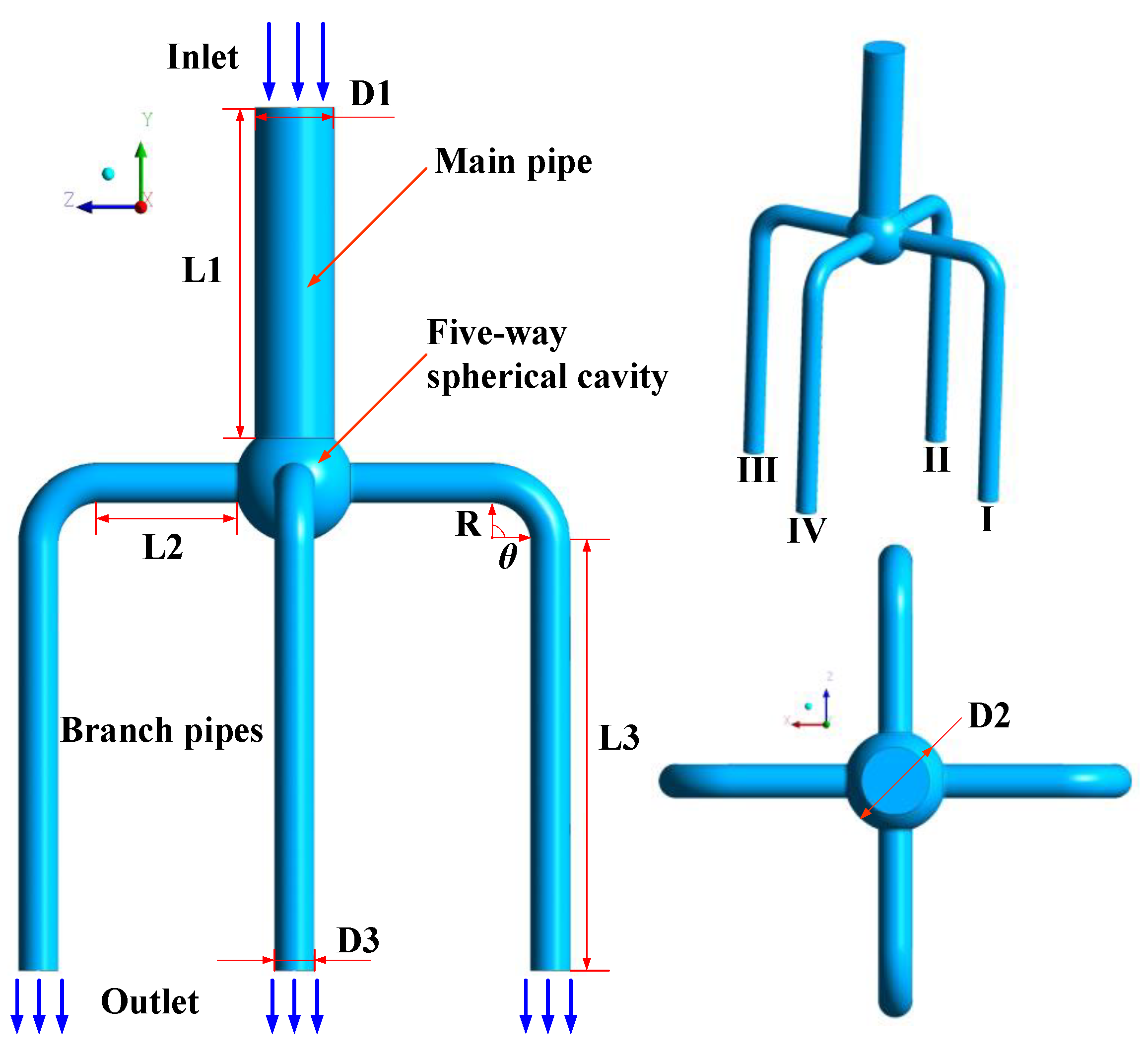
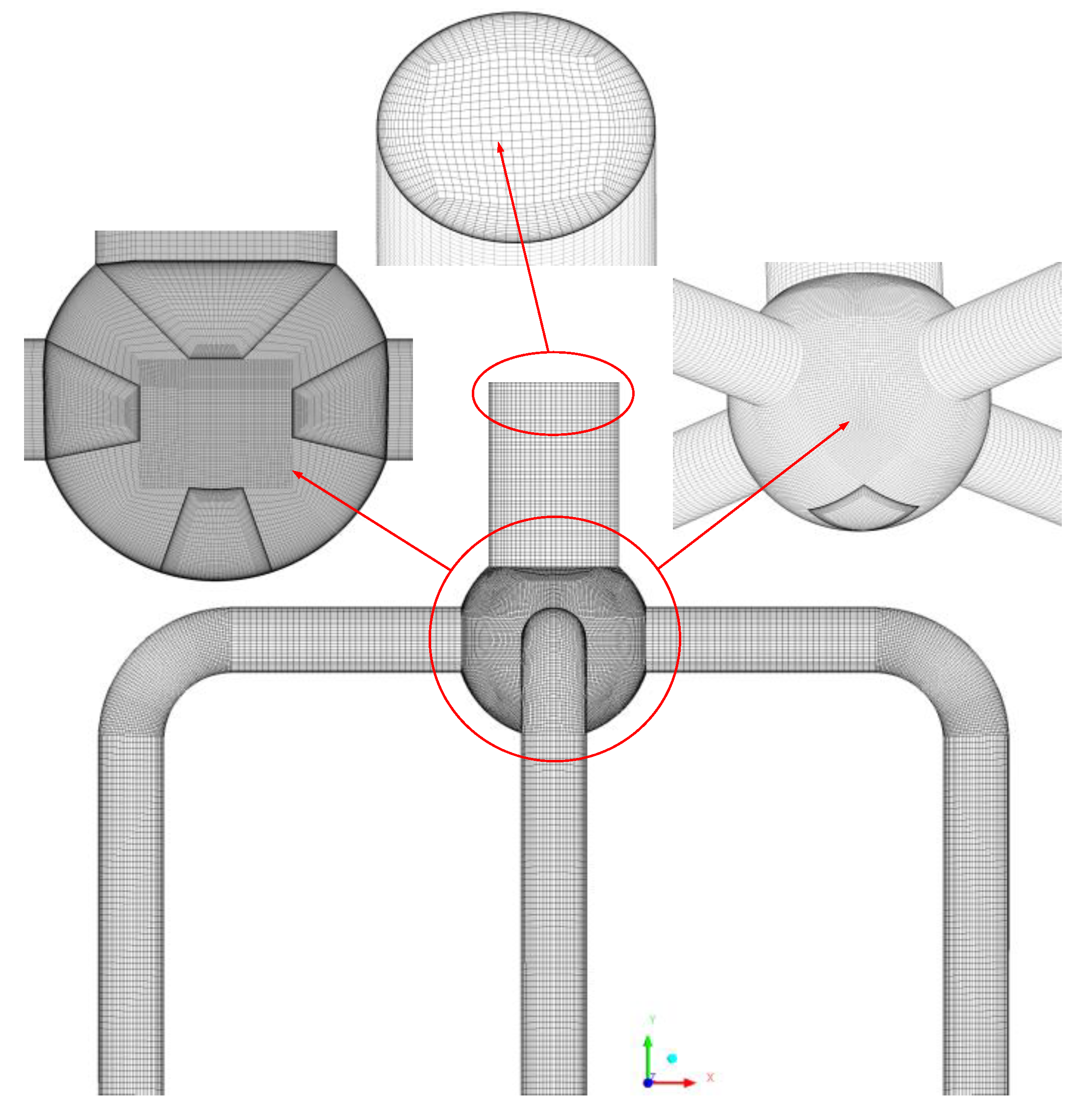
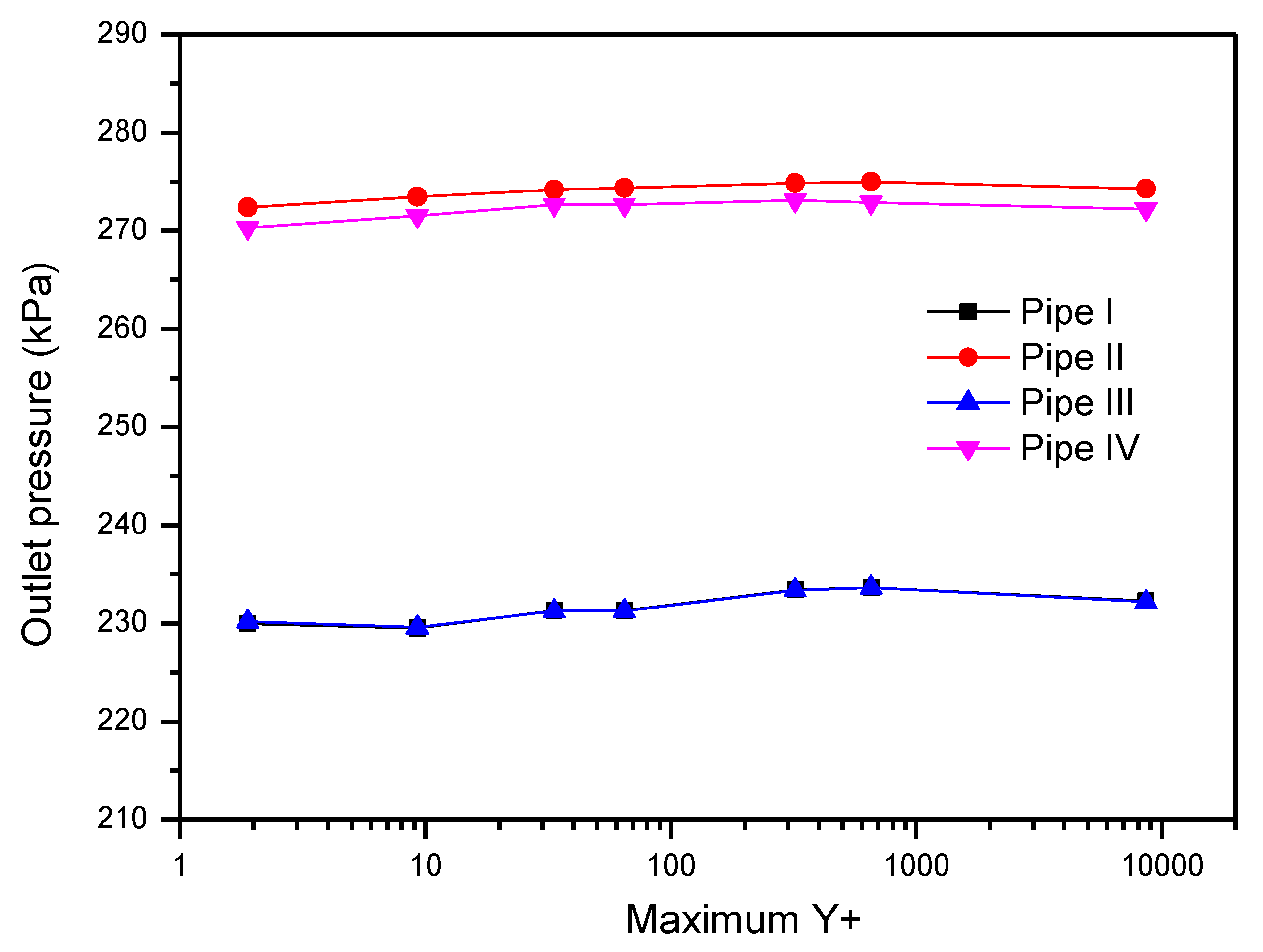

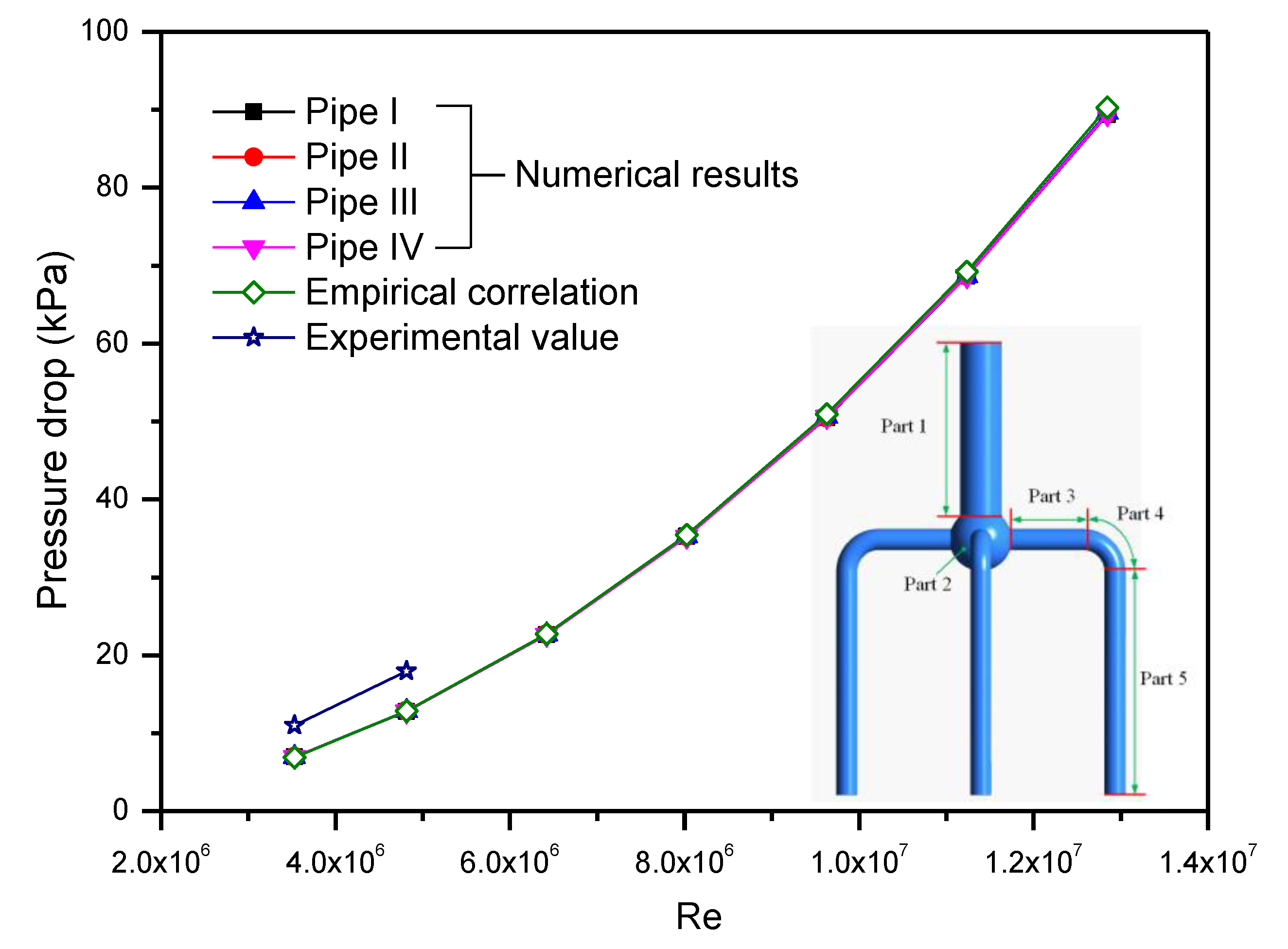



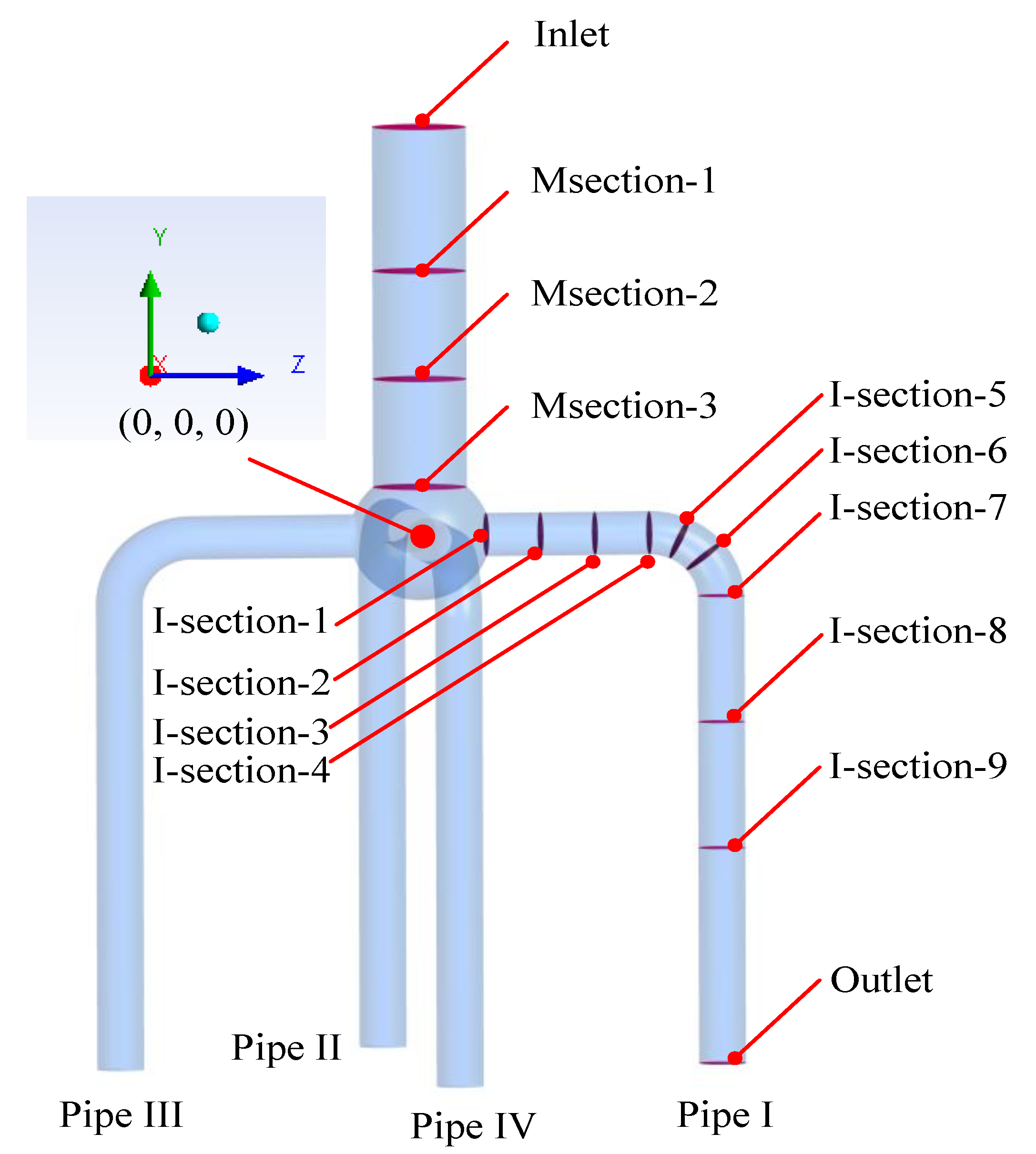
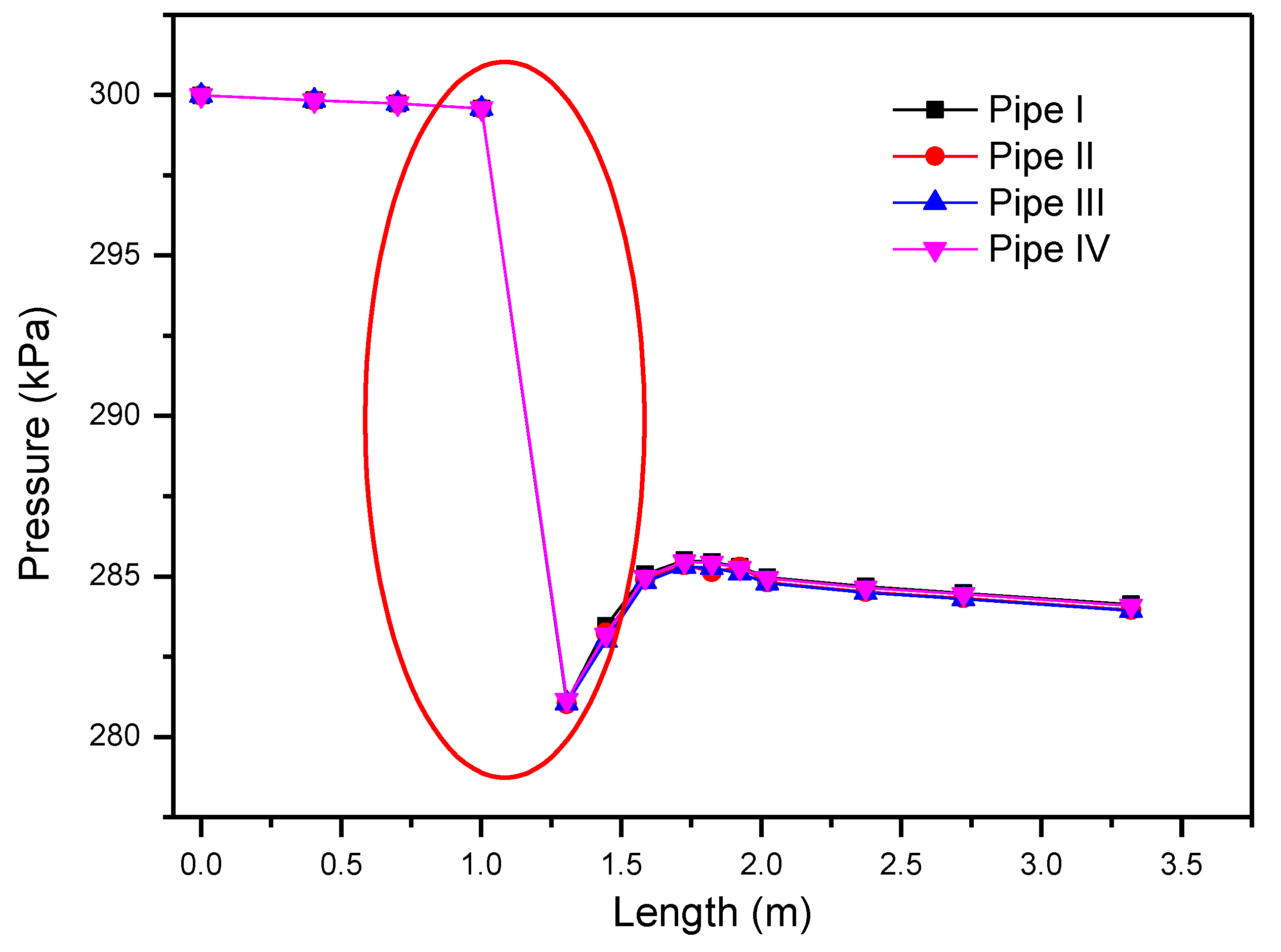
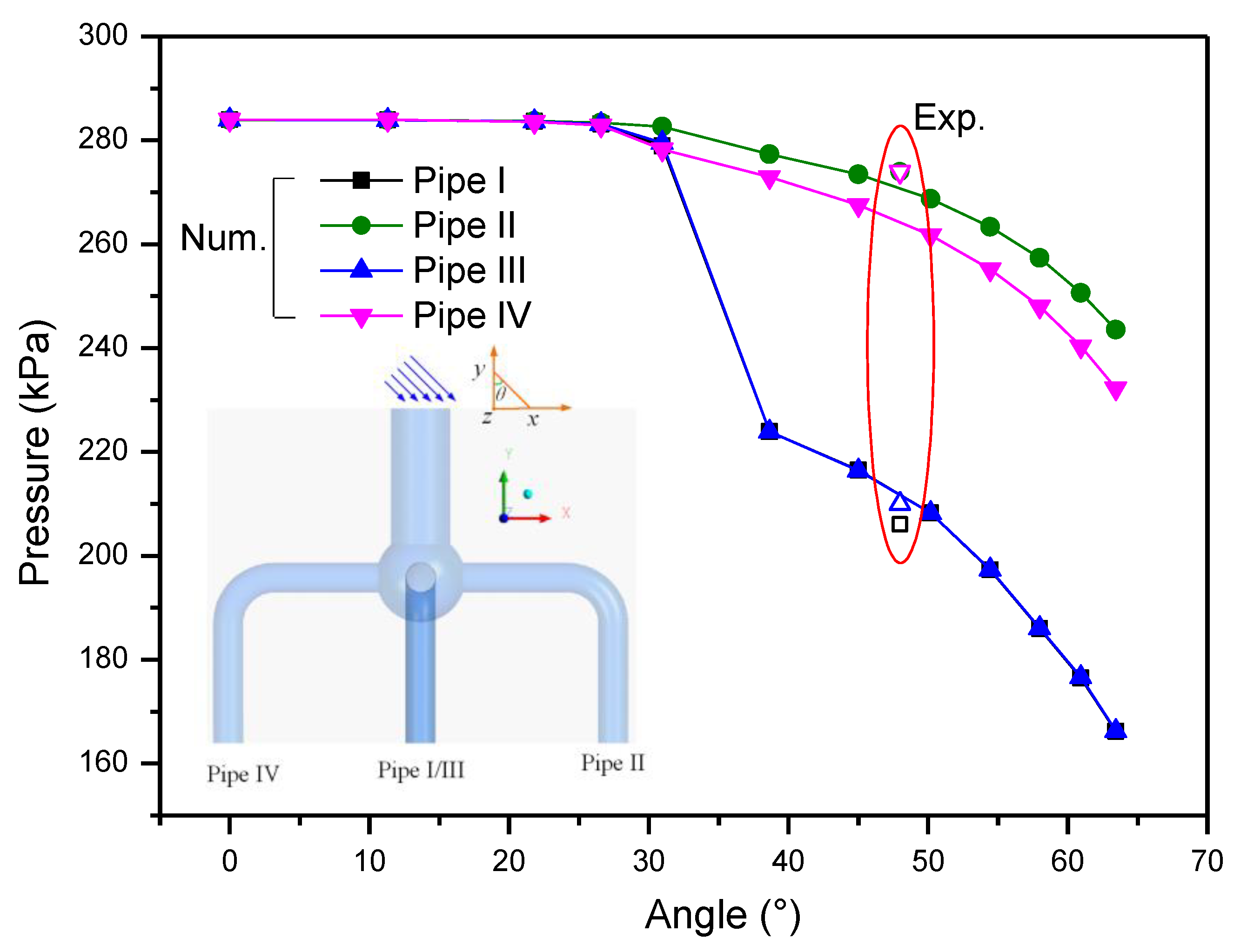
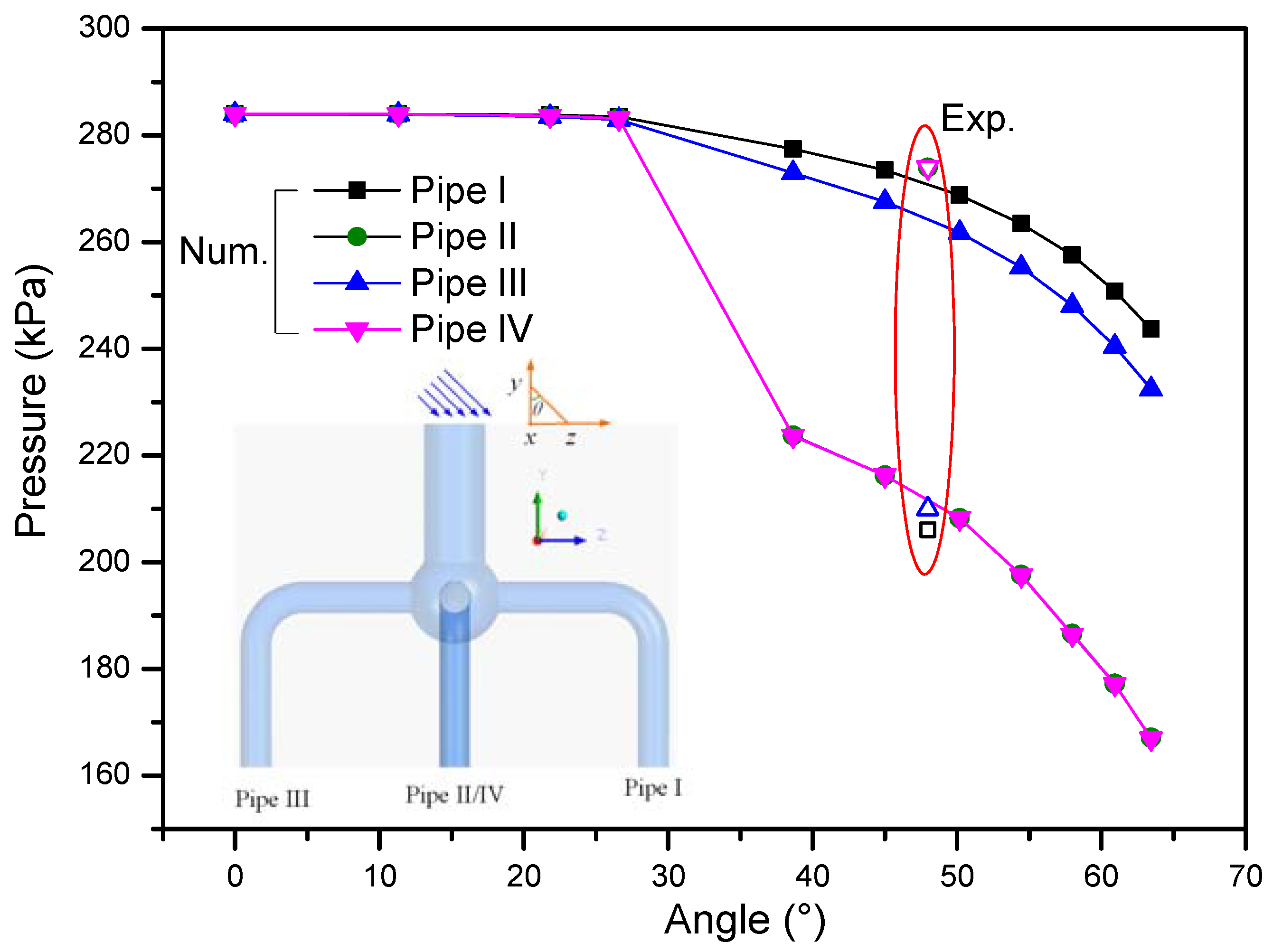
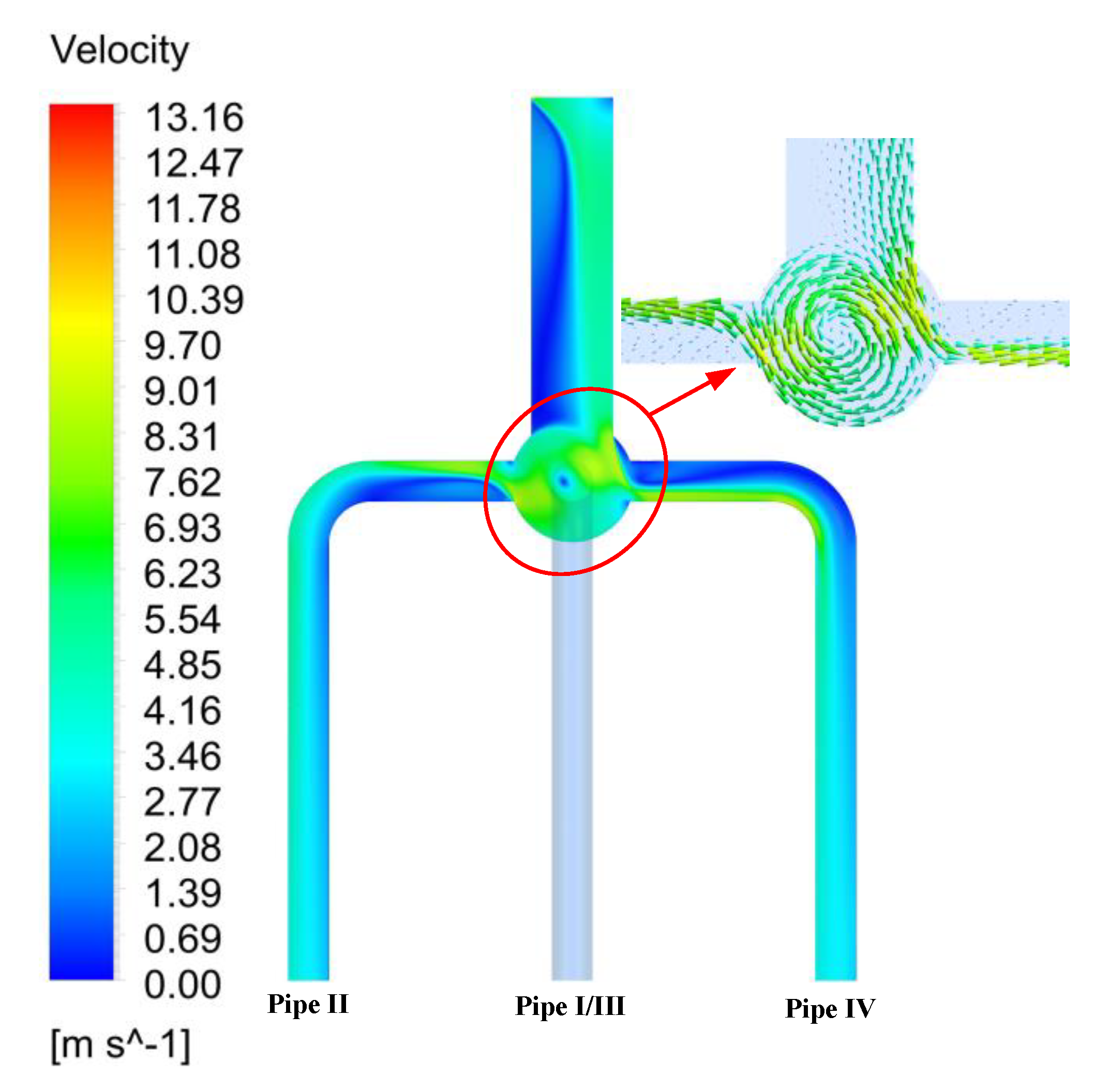


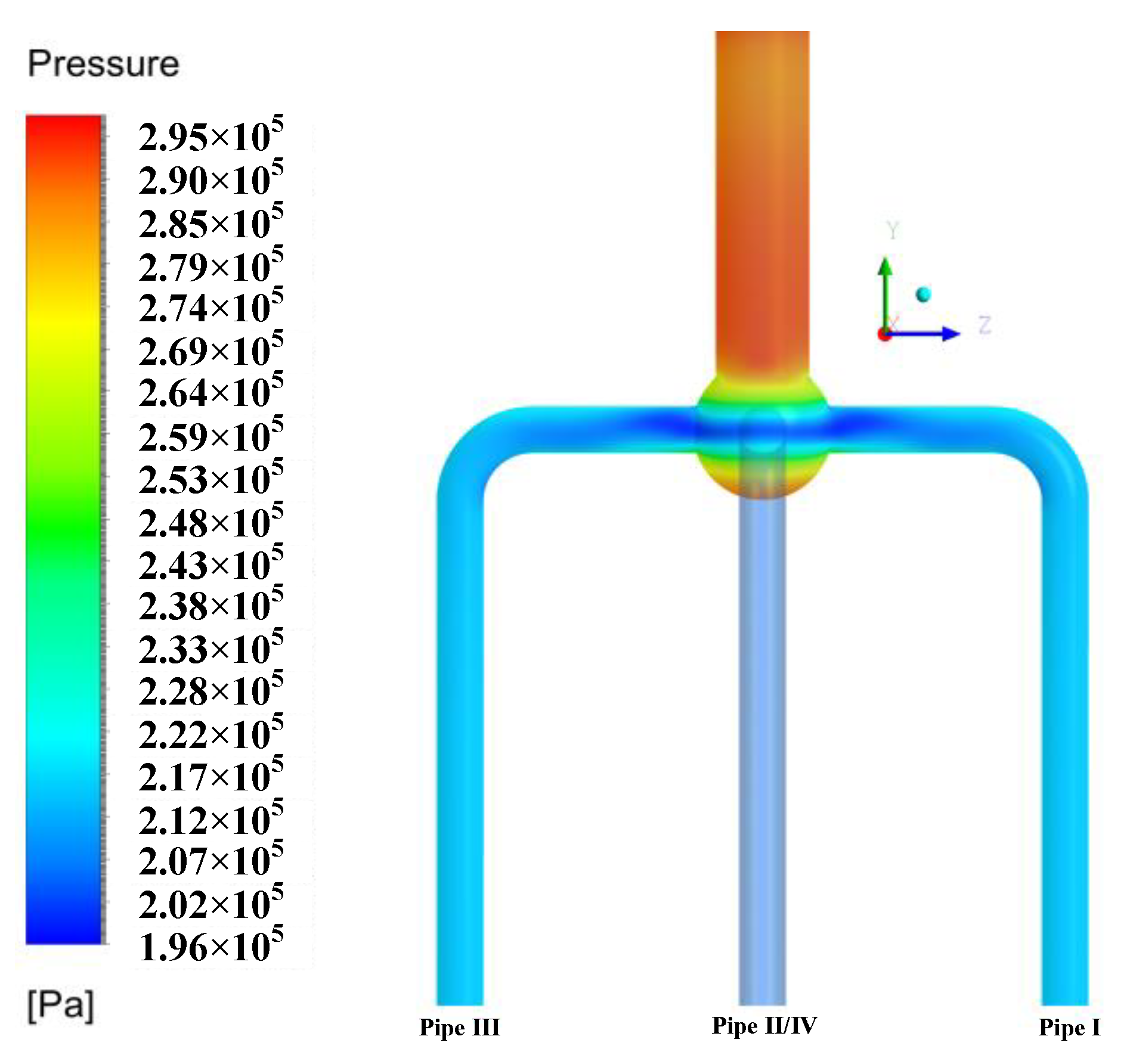
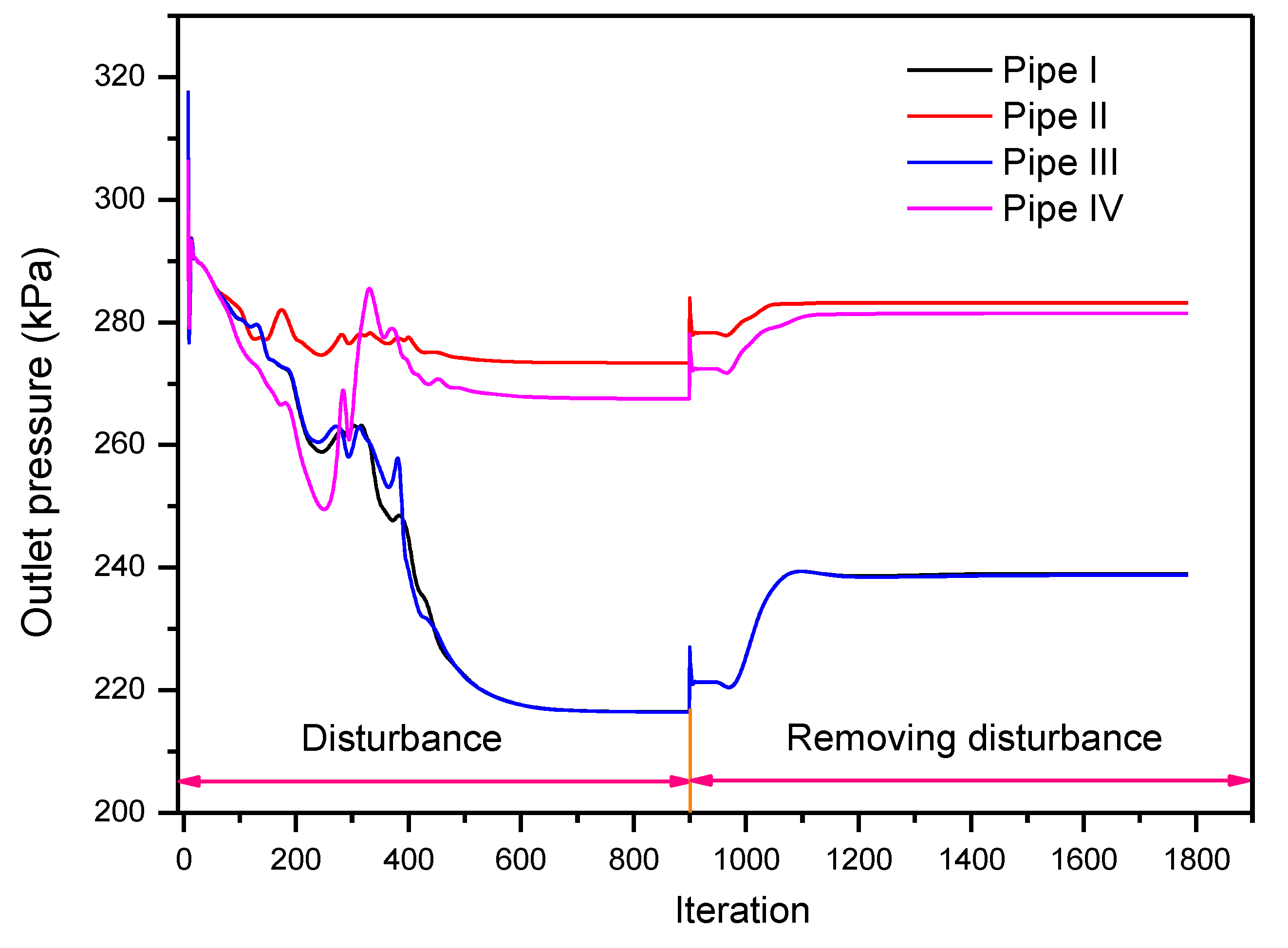
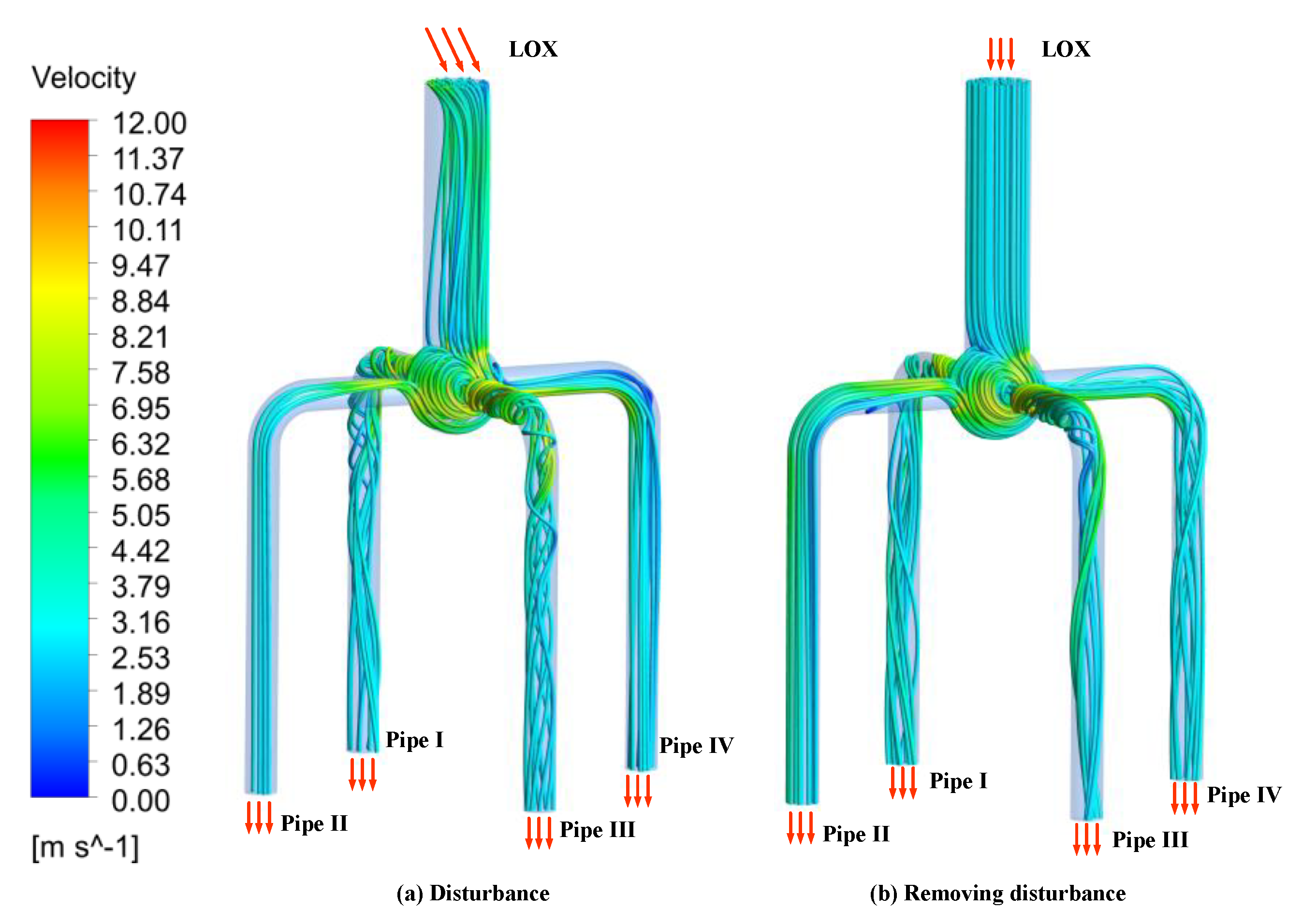
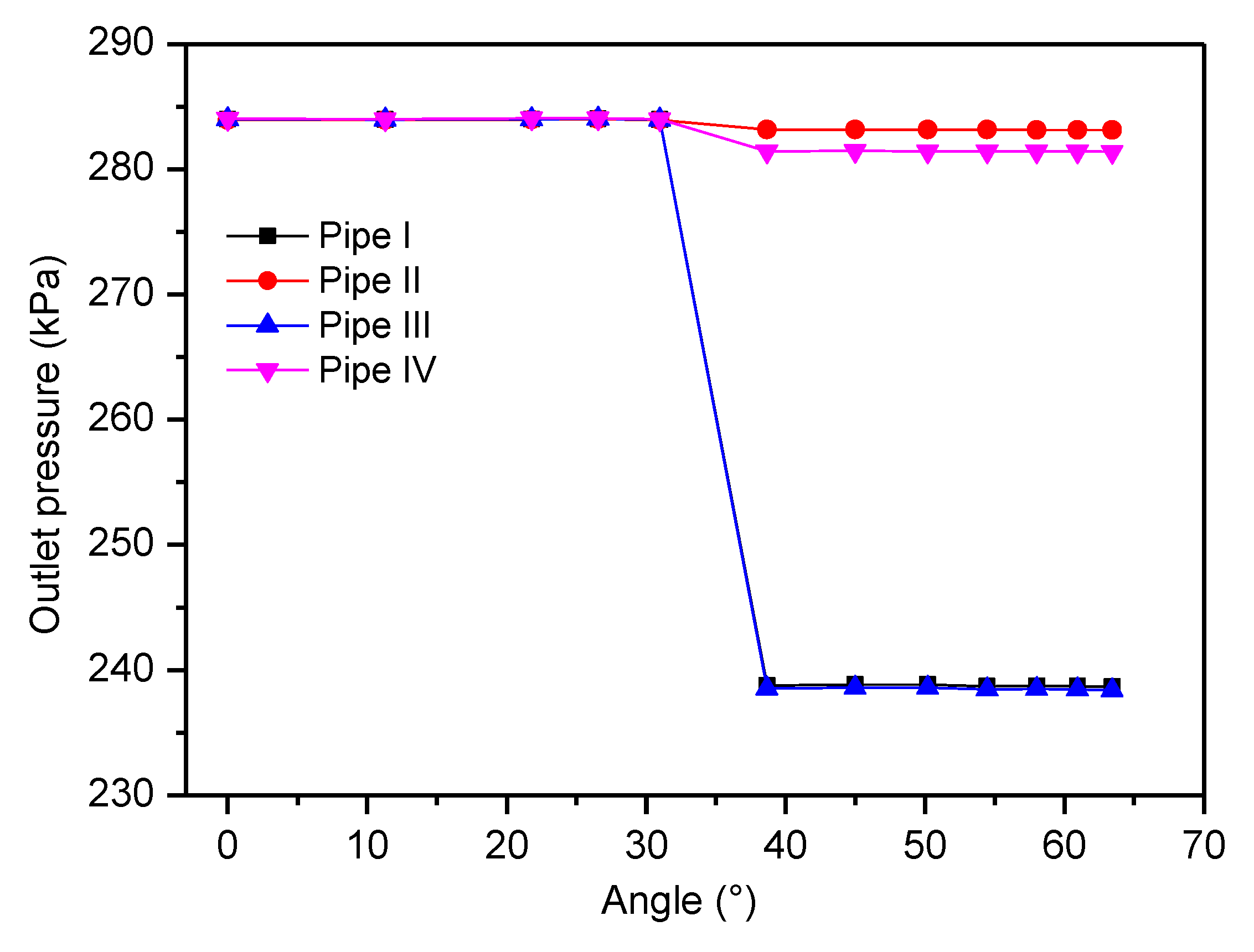
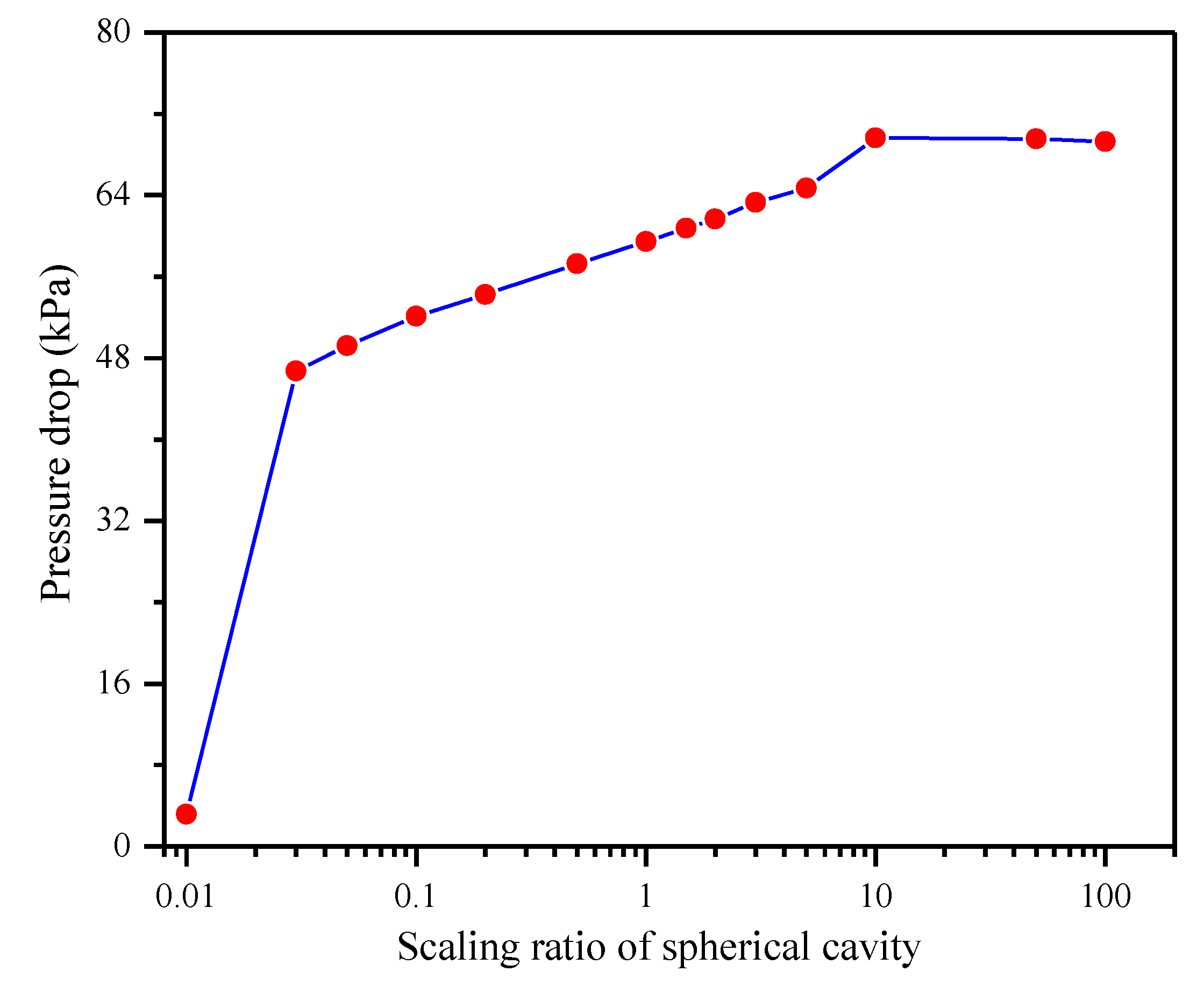
| Names | Unit | Value | |
|---|---|---|---|
| Main pipe | Diameter (D1) | mm | 240 |
| Length (L1) | mm | 1000 | |
| Five-way spherical cavity | Diameter (D2) | mm | 360 |
| Branch pipes | Diameter (D3) | mm | 120 |
| Horizontal length (L2) | mm | 410 | |
| Radius of bend pipe (R) | mm | 185 | |
| Angle of bend pipe (θ) | ° | 87 | |
| Vertical length (L3) | mm | 1300 | |
| Name | Location (mm) | Name | Location (mm) |
|---|---|---|---|
| Inlet | (0, 1135, 0) | I-Section-4 | (0, 0, 590) |
| Msection-1 | (0, 734.16, 0) | I-Section-5 | (0, −20, 665) |
| Msection-2 | (0, 434.16, 0) | I-Section-6 | (0, −68, 729) |
| Msection-3 | (0, 134.16, 0) | I-Section-7 | (0, −177, 770) |
| I-Section-1 | (0, 0, 170) | I-Section-8 | (0, −527, 770) |
| I-Section-2 | (0, 0, 310) | I-Section-9 | (0, −877, 770) |
| I-Section-3 | (0, 0, 450) | Outlet | (0, −1475, 770) |
© 2020 by the authors. Licensee MDPI, Basel, Switzerland. This article is an open access article distributed under the terms and conditions of the Creative Commons Attribution (CC BY) license (http://creativecommons.org/licenses/by/4.0/).
Share and Cite
Xie, F.; Xia, S.; Chen, E.; Li, Y.; Mao, H.; Ma, Y. Numerical Investigation on Instability Flow Behaviors of Liquid Oxygen in a Feeding Pipeline with a Five-Way Spherical Cavity. Energies 2020, 13, 926. https://doi.org/10.3390/en13040926
Xie F, Xia S, Chen E, Li Y, Mao H, Ma Y. Numerical Investigation on Instability Flow Behaviors of Liquid Oxygen in a Feeding Pipeline with a Five-Way Spherical Cavity. Energies. 2020; 13(4):926. https://doi.org/10.3390/en13040926
Chicago/Turabian StyleXie, Fushou, Siqi Xia, Erfeng Chen, Yanzhong Li, Hongwei Mao, and Yuan Ma. 2020. "Numerical Investigation on Instability Flow Behaviors of Liquid Oxygen in a Feeding Pipeline with a Five-Way Spherical Cavity" Energies 13, no. 4: 926. https://doi.org/10.3390/en13040926





